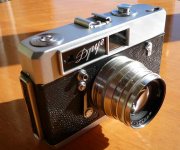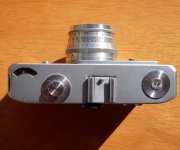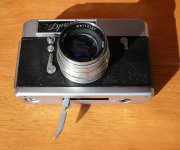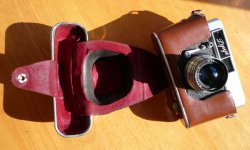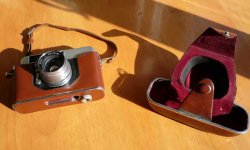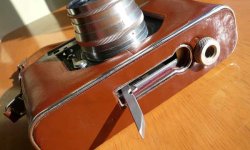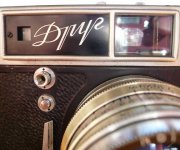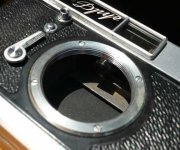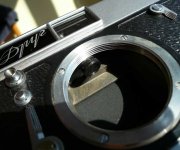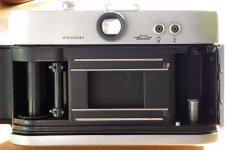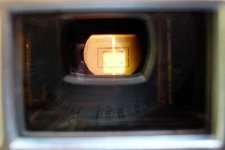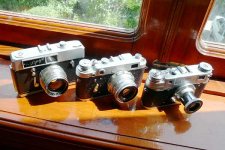rxmd
May contain traces of nut
Here are some pictures of the 1961 Drug that I picked up the day before yesterday from my Armenian camera-collector-turned-camera-salesman here in Tashkent for $60. Judging from the thread title, I can see why people usually spell the camera "Droug" or "Droog" instead 🙂
The Drug is a Leica thread mount rangefinder camera produced at the Krasnogorsk factory between 1960 and 1962. The name "ДРУГ", pronounced "droog", means "friend" in Russian. In total, about 23,000 were made, making it an uncommon, but not rare camera. According to Princelle, it was meant as KMZ's answer to the Leningrad, which, unlike the Drug, was exported, produced in slightly larger numbers (78,000 according to Princelle) and over a longer period of time (1958 to 1968)
The Drug is a beautiful camera. As you can see, the camera body is very well designed, with clear lines and avoiding unnecessary cluttering of the controls. Its outward appearance completely departs from the FSU's heritage of Leica copies. Workmanship and build quality on the camera is excellent, better than on most other FSU cameras I've seen. The lens is a 1961 Jupiter-8 with very smooth focus and aperture rings; it could well be the original lens the camera came with.

You can see the layout of controls on the top plate. On the left there is the frame counter, recessed beneath a little window and set by means of a serrated wheel that protrudes a little on the left, then the shutter speed dial, an accessory shoe and a film reminder deal. Shutter speeds go from 1/2 to 1/1000 plus B. The form of the body is quite unique, with its flat front and gently curved back.

On the bottom, you can see the fold-out trigger winder borrowed from the Canon VT and the Leicavit. It drives the winding axle by means of a brass chain. On the left, there is a recessed bottom rewind knob, held inside by means of a spring. On the right there is a European 3/8" tripod bushing.

The Drug is a Leica thread mount rangefinder camera produced at the Krasnogorsk factory between 1960 and 1962. The name "ДРУГ", pronounced "droog", means "friend" in Russian. In total, about 23,000 were made, making it an uncommon, but not rare camera. According to Princelle, it was meant as KMZ's answer to the Leningrad, which, unlike the Drug, was exported, produced in slightly larger numbers (78,000 according to Princelle) and over a longer period of time (1958 to 1968)
The Drug is a beautiful camera. As you can see, the camera body is very well designed, with clear lines and avoiding unnecessary cluttering of the controls. Its outward appearance completely departs from the FSU's heritage of Leica copies. Workmanship and build quality on the camera is excellent, better than on most other FSU cameras I've seen. The lens is a 1961 Jupiter-8 with very smooth focus and aperture rings; it could well be the original lens the camera came with.
You can see the layout of controls on the top plate. On the left there is the frame counter, recessed beneath a little window and set by means of a serrated wheel that protrudes a little on the left, then the shutter speed dial, an accessory shoe and a film reminder deal. Shutter speeds go from 1/2 to 1/1000 plus B. The form of the body is quite unique, with its flat front and gently curved back.
On the bottom, you can see the fold-out trigger winder borrowed from the Canon VT and the Leicavit. It drives the winding axle by means of a brass chain. On the left, there is a recessed bottom rewind knob, held inside by means of a spring. On the right there is a European 3/8" tripod bushing.
Attachments
Last edited:


